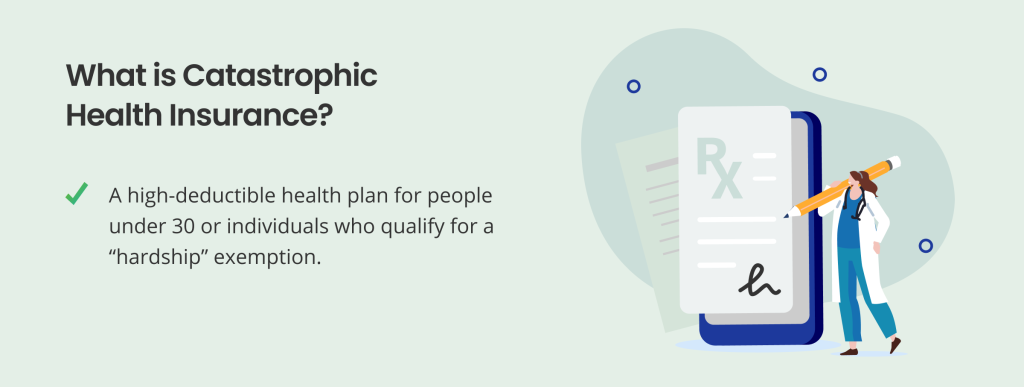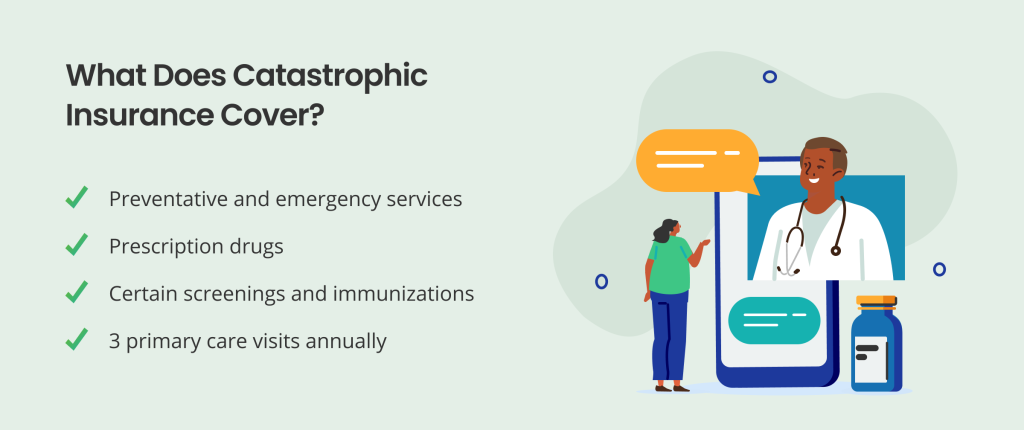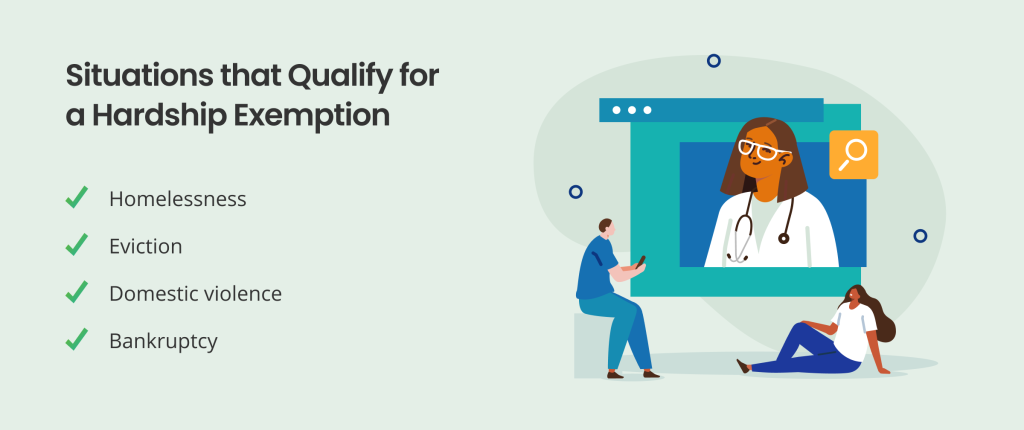
Find catastrophic health plans with eHealth today
Health insurance can be expensive to pay for out of pocket, but the potential cost of a major medical issue can be even higher. Catastrophic health insurance plans balance low premium costs with coverage for the worst possible medical problems. This is a type of high-deductible health plan for people under 30 or those who qualify for a “hardship” exemption.
Catastrophic plans are designed to protect you in a worst-case scenario. For example, if you get into an emergency and your medical expenses total thousands of dollars. Monthly plan premiums tend to be lower, but you’ll generally need to pay for all healthcare costs out of pocket until you reach the plan’s annual deductible, which is usually at least a couple of thousand dollars.
Here is an overview of how catastrophic coverage works, including benefits and costs. We will also go over whether this type of plan may work for your situation.

What is catastrophic health insurance?
Catastrophic health insurance provides emergency medical insurance with below-average costs. Policies are characterized by low monthly premiums, high deductibles, and high out-of-pocket maximums.
As the name implies, catastrophic insurance primarily provides coverage for catastrophic medical events or worst-case scenarios.
This plan typically doesn’t pay for routine non-preventative care, and the costs of minor surgeries and short emergency room visits are unlikely to reach a catastrophic plan’s threshold for coverage.
Catastrophic health coverage differs from accident, critical illness, or short-term plans; these types of coverage protect the policyholder in specific, limited situations. For example, critical illness plans insure the policyholder against explicit health illnesses. Short-term plans provide limited, temporary coverage when an individual isn’t eligible to enroll in a major medical health plan or is waiting for coverage to start. For example, you might enroll in a short-term plan to fill a coverage gap before you’re eligible for Medicare.
When is catastrophic health insurance needed?
Catastrophic health plans cover the same minimum health benefits as other health plans under the Affordable Care Act, including preventive services, emergency services, prescription drugs, and more. The difference with a catastrophic plan is that you must pay for all healthcare costs until you meet a high annual deductible.
There aren’t specific injuries and illnesses that catastrophic health insurance provides coverage for. Instead, the insurance generally covers injuries and conditions if the treatment proves to be extremely expensive. Only after your out-of-pocket spending reaches the deductible does your plan begin to pay for most covered healthcare services.
Catastrophic health insurance is typically needed for unexpected, serious medical events that result in high healthcare costs. Some scenarios where catastrophic insurance may be beneficial include major accidents, sudden severe illnesses, or unexpected hospitalizations.

Eligibility and requirements
Who qualifies for catastrophic health insurance?
Most people who purchase catastrophic health insurance fall into either of two categories. In both cases, coverage typically isn’t available from an employer or through a spouse’s work.
First, young adults sometimes purchase this coverage if they believe their risk of major medical expenses is low. They might get a catastrophic policy to meet legal requirements, and just in case something horrible does happen. They may also choose to pay for small or moderate expenses themselves, partly because the likelihood of accumulating significant medical debt is relatively small for young, healthy adults.
Second, adults and families may purchase coverage during difficult financial times. When coverage isn’t available from an employer and money is tight, such as following a layoff, firing, or disability-related leave of absence, catastrophic health insurance makes coverage affordable.
Age limitations and enrollment criteria
Catastrophic health insurance is often available to individuals under the age of 30 or those who qualify for a hardship exemption. In the first group (those under 30), this type of insurance is designed to provide a safety net in case of unexpected major medical expenses. For the second group (those with hardship exemptions), catastrophic insurance may be an option for individuals who cannot afford other health insurance plans or face certain financial difficulties, as determined by the government. It’s important to check specific eligibility criteria with insurance providers and healthcare authorities to ensure you meet the requirements for catastrophic coverage.
Key features of catastrophic health insurance
Low premiums, high deductibles
Catastrophic health insurance plans typically come with low monthly premiums but high deductibles. This means that policyholders pay a relatively small amount each month to maintain coverage, making it an affordable option for budget-conscious individuals, especially those under 30 or with hardship exemptions.
However, the trade-off is a high deductible, which is the amount you must pay out of pocket for covered healthcare services before your insurance starts contributing. The high deductible is designed to protect policyholders from financial ruin in the event of a major medical expense, such as a serious accident or illness.
In essence, catastrophic insurance is a safety net for unexpected, significant healthcare costs. It provides peace of mind and financial protection against the most severe medical situations while keeping monthly premiums affordable. It’s essential to carefully consider your healthcare needs and budget when deciding if this type of insurance is the right choice for you.
Coverage for essential health benefits
Catastrophic health insurance plans typically cover essential health benefits, which are a set of healthcare services and items that all insurance plans, including catastrophic plans, must cover under the Affordable Care Act (ACA). These essential health benefits include:
- Preventive Services: Catastrophic plans often cover a range of preventive services at no cost to you. This may include vaccinations, screenings, and annual check-ups.
- Emergency Services: Coverage for emergency room visits and emergency medical transportation is included, making it a valuable option in case of accidents or sudden severe illnesses.
- Hospitalization: Catastrophic plans provide coverage for hospital stays, surgeries, and related medical care. This is crucial for major medical events.
- Prescription Drugs: While catastrophic plans typically have a high deductible, they may offer some coverage for prescription medications after the deductible is met.
- Mental Health and Substance Use Disorder Services: Catastrophic plans include coverage for mental health services and substance abuse treatment.
- Rehabilitative and Habilitative Services: Coverage for rehabilitation and habilitation services, such as physical therapy, occupational therapy, and speech therapy, is often provided.
- Pregnancy, Maternity, and Newborn Care: Catastrophic plans cover services related to pregnancy, maternity, and care for newborns, which is an essential benefit for those planning to start or expand their families.
- Pediatric Services: Coverage for pediatric services, including well-child visits, dental, and vision care, is part of the essential health benefits package.
It’s important to note that while catastrophic plans cover these essential health benefits, you’ll generally need to meet the high deductible before insurance kicks in. Therefore, these plans are primarily intended for young, healthy individuals who want financial protection against major medical expenses but are willing to pay lower premiums in exchange for a higher out-of-pocket threshold.
Limitations on out-of-pocket costs
Catastrophic health insurance plans, despite their low premiums, come with limitations on out-of-pocket costs. These limitations are designed to provide some financial protection in case of major medical expenses. Here’s a deeper look at how these limitations work:
- Annual Out-of-Pocket Maximum: Catastrophic plans have an annual out-of-pocket maximum or limit on how much you’ll have to pay for covered healthcare services in a given year. This maximum amount is set by the government and can change from year to year. For 2023, the maximum limit for catastrophic plans is $8,700 for an individual.
- Coverage After Meeting the Deductible: Before your catastrophic plan starts covering most healthcare costs, you’ll need to meet a high deductible. In 2023, the deductible for catastrophic plans can’t exceed $8,700. Once you’ve paid this amount out of your pocket for covered services, your plan will generally start covering a significant portion of your healthcare expenses.
- Coverage for Essential Health Benefits: Catastrophic plans must cover essential health benefits, which include services like preventive care, emergency care, hospitalization, and prescription drugs. These services are covered after you’ve met your deductible, which means you’ll have some financial protection for major medical events.
- Limited Coverage for Routine Care: Catastrophic plans are not designed for routine or day-to-day healthcare needs. You’ll typically be responsible for the full cost of routine doctor visits, preventive care, and other minor medical expenses until you reach your deductible.
- Preventive Services at No Cost: One exception is preventive services. Catastrophic plans often cover preventive services at no cost to you, even before you’ve met your deductible. This is a valuable feature that encourages preventive care.
In summary, catastrophic health insurance plans provide a safety net for major medical expenses while keeping premiums low. However, they require you to pay a significant amount out of pocket before major coverage kicks in. Therefore, they are most suitable for young, healthy individuals who want financial protection against worst-case scenarios but are willing to manage routine healthcare expenses on their own.
Pros and cons of catastrophic health insurance
Pros of Catastrophic Health Insurance:
- Low Premiums: Catastrophic plans typically have some of the lowest monthly premiums among all health insurance options, making them affordable for budget-conscious individuals.
- Protection Against Major Medical Expenses: These plans provide financial protection in case of serious accidents or illnesses, ensuring that you won’t be burdened with overwhelming medical bills.
- Coverage for Essential Health Benefits: Catastrophic plans cover essential health benefits like hospitalization, emergency care, and prescription drugs once you meet your deductible.
- Preventive Services at No Cost: Many preventive services, such as vaccinations and screenings, are covered at no cost, even before meeting the deductible.
- Option for Young, Healthy Individuals: Catastrophic plans are designed for young, healthy individuals who don’t anticipate needing frequent medical care and want a safety net for unexpected events.
Cons of Catastrophic Health Insurance:
- High Deductibles: Catastrophic plans come with high deductibles, which means you’ll need to pay a significant amount out of pocket for most healthcare services before coverage begins.
- Limited Coverage for Routine Care: Routine doctor visits, preventive care, and minor medical expenses are not covered until you reach your deductible. You’ll be responsible for these costs.
- Age and Eligibility Restrictions: Catastrophic plans are typically available only to individuals under 30 or those who qualify for a hardship exemption. They may not be suitable for older adults or families.
- No Subsidies: Catastrophic plans do not qualify for premium subsidies through the Health Insurance Marketplace, so you’ll pay the full premium cost.
- Risk of Paying More in the Long Run: While premiums are low, if you don’t use your catastrophic coverage for major medical expenses, you may end up paying more out of pocket over time than with other types of health insurance.
It’s essential to carefully consider your health and financial situation when deciding on catastrophic health insurance. While it can provide significant protection in emergencies, it may not be the best choice if you require regular medical care or have chronic health conditions.
Is catastrophic health insurance right for you?
If health insurance isn’t available from another source, catastrophic health insurance may be worth getting. This is typically the most affordable way to purchase health insurance, and it can be much more affordable than other options, such as COBRA coverage. Many people buy it as temporary emergency medical insurance.
In these situations, expensive medical costs wouldn’t be covered if this insurance isn’t in place. The low premiums often make a short-term health insurance policy worth getting in order to avoid potentially bankrupting medical expenses if something happens.
Of course, individuals under 30 might determine that purchasing this type of policy is preferable to other insurance policy options. This is a personal decision, and not everyone will come to the same conclusion.
If you’re unsure whether catastrophic health insurance is right for your situation, you can request quotes without enrolling in a policy. There’s no cost for requesting quotes, and looking at them brings no obligation to enroll in a plan. This is the most informative way to evaluate coverage options for yourself or your family.
How to enroll in catastrophic health insurance
To enroll in a catastrophic health plan, you must meet one of the following eligibility requirements:
- Be under 30 years old, or
- Qualify for a “hardship exemption” (a situation that prevents you from being able to afford health coverage)
If you are over 30 and interested in catastrophic health coverage, you must qualify for a hardship exemption. Some examples of hardship exemptions include if you were homeless in the last three years or were found ineligible for Medicaid because your state didn’t expand its Medicaid program. Other situations that may allow you to qualify for a hardship exemption include eviction, domestic violence, and bankruptcy.

If you think you may qualify for an exemption because of financial hardship, you’ll need to apply for a hardship exemption through the Marketplace. If you receive a notice stating that you qualify for a hardship exemption, you have the option to purchase a catastrophic insurance plan, and an eHealth licensed insurance agent would be happy to help you find a plan that may work for you. You can also choose to enroll in a major medical plan instead.
Keep in mind that if you qualify for lower healthcare costs because of income (also known as a subsidy), you cannot apply these savings towards a catastrophic health plan. This includes premium tax credits and cost-sharing subsidies. So, you’ll pay the standard premium amount for your catastrophic insurance plan, regardless of your income level.
You should also compare available plans since not all catastrophic plans are the same. Just how high you want the deductible and out-of-pocket maximum depends on your situation.
FAQs about catastrophic health insurance
What are the premiums for catastrophic plans?
Catastrophic plans typically have low monthly premiums, which are the regular payments you make to maintain your health insurance coverage. These low premiums are one of the primary advantages of catastrophic insurance, making it an affordable option for many individuals.
Can you use catastrophic insurance for routine care?
Catastrophic insurance is primarily designed to protect you from high medical expenses in the event of a major illness or injury. It does not provide coverage for routine care, such as doctor’s office visits or prescription medications, until you have met the high deductible. Therefore, it is not intended for routine or day-to-day healthcare needs.
How does catastrophic insurance affect tax penalties?
If you have catastrophic insurance, you may still be subject to tax penalties if you do not meet the criteria for an exemption and go without coverage for more than three months during the year. Catastrophic plans do not qualify as minimum essential coverage under the Affordable Care Act, which means they may not exempt you from penalties associated with the individual mandate. It’s important to understand the tax implications and potential penalties associated with this type of coverage when considering catastrophic insurance.

